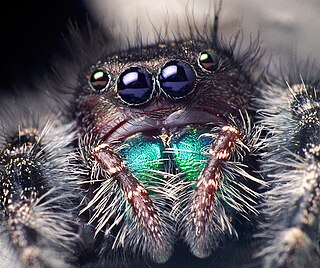
Phidippus is a genus in the family Salticidae. Some of the largest jumping spiders inhabit this genus, and many species are characterized by their brilliant, iridescent green chelicerae. Phidippus is distributed almost exclusively in North America, with the exception of two exported species. As of January 2021, there were about 80 described species in the genus. Species previously described in Phidippus which are found in India and Bangladesh do not belong in this genus.

Bagheera is a genus of jumping spiders within the family Salticidae, subfamily Salticinae and subtribe Dendryphantina. The genus was first described by George Peckham & Elizabeth Peckham in 1896. The name is derived from Bagheera, a character from Rudyard Kipling's Jungle Book.
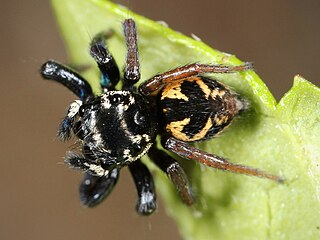
Corythalia is a genus of jumping spiders that was first described by Carl Ludwig Koch in 1850.
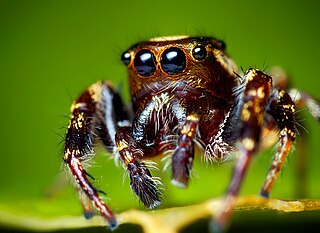
Eris is a genus of the spider family Salticidae. It is native to North and South America. As is typical for salticids, they are not defensive. While larger specimens could potentially bite, an envenomation would pose no danger to a human.

Hentzia is a genus of the spider family Salticidae subfamily Dendryphantinae. The genus is widespread in North America and northern South America but the center of biodiversity seems to be primarily in the Caribbean and surrounding areas, with the greatest species diversity occurring in Cuba, which has seven species. Some outlier species, such as Hentzia poenitens and Hentzia fimbriata are found in western North America. It appears to be closely related to the genus Anicius from which it differs primarily in certain anatomical details.

Maevia is a spider genus of the family Salticidae.

Marpissa is a genus of jumping spiders that was first described by Carl Ludwig Koch in 1846. The name is derived from Marpissa, an ancient Greek village.

Zygoballus is a genus of jumping spiders found in North and South America.
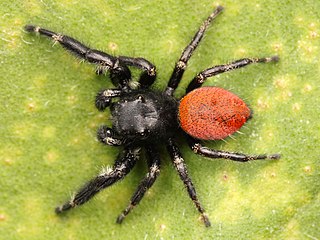
Phidippus johnsoni, the red-backed jumping spider, is one of the largest and most commonly encountered jumping spiders of western North America. It is not to be confused with the unrelated and highly venomous redback spider.

Zygoballus sexpunctatus is a species of jumping spider which occurs in the southeastern United States where it can be found in a variety of grassy habitats. Adult spiders measure between 3 and 4.5 mm in length. The cephalothorax and abdomen are bronze to black in color, with reddish brown or yellowish legs. The male has distinctive enlarged chelicerae and front femora. Like many jumping spiders, Z. sexpunctatus males exhibit ritualized courtship and agonistic behavior.

Zygoballus rufipes, commonly called the hammerjawed jumper, is a species of jumping spider which occurs in the United States, Canada, and Central America. Adult females are 4.3 to 6 mm in body length, while males are 3 to 4 mm.

Zygoballus nervosus is a species of jumping spider which occurs in the eastern United States and Canada.

Peckhamia is a peer-reviewed, open-access, scientific journal covering research on jumping spiders. It is published by the Peckham Society, an international organization of naturalists and scientists with an interest in jumping spiders, named in honor of George and Elizabeth Peckham. The journal was established in 1977 and its current editor-in-chief is David E. Hill.

Colonus is a genus of spiders in the jumping spider family, Salticidae. Colonus species are endemic to North and South America, ranging from New York to Argentina. All members of the genus have two pairs of bulbous spines on the ventral side of the first tibiae. The function of these spines is unknown. Colonus was declared a junior synonym of Thiodina by Eugène Simon in 1903, but this was reversed by Bustamante, Maddison, and Ruiz in 2015.
Marpissa robusta is a species of jumping spider in the family Salticidae. It is found in the United States.
Marpissa obtusa is a species of jumping spider in the family Salticidae. It is found in the United States.

Marpissa formosa is a species of jumping spider in the family Salticidae. It is found in the United States.

Marpissa bina is a species of jumping spider in the family Salticidae. It is found in the United States.
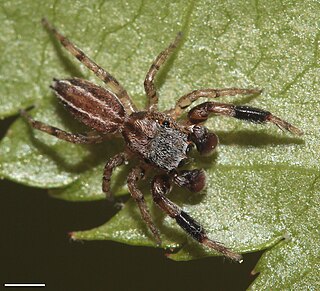
Marpissa lineata is a species of jumping spider in the family Salticidae. It is found in the United States.

















